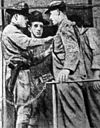- Memorial Day massacre of 1937
-
This article is about the Memorial Day Massacre. For the Celtics game, see 1985 NBA Finals.
 Photograph from the United States Archives titled "The Chicago Memorial Day Incident".
Photograph from the United States Archives titled "The Chicago Memorial Day Incident".
In the Memorial Day massacre of 1937, the Chicago Police Department shot and killed ten unarmed demonstrators in Chicago, on May 30, 1937. The incident took place during the "Little Steel Strike" in the United States.
The incident arose after U.S. Steel signed a union contract but smaller steel manufacturers (called 'Little Steel'), including Republic Steel, refused to do so. In protest, the Steel Workers Organizing Committee (SWOC) of the Congress of Industrial Organizations (CIO) called a strike. On Memorial Day, hundreds of sympathizers gathered at Sam's Place, headquarters of SWOC. As the crowd marched across the prairie towards the Republic Steel mill, a line of Chicago policeman blocked their path. When the foremost protestors argued their right to continue, a tree branch was tossed at the police lines[1] and the police fired on the crowd. As the crowd fled, police bullets killed ten people and injured 30. Nine people were permanently disabled and another 28 had serious head injuries from police clubbing.
Years later, one of the protesters, Mollie West, recalled a policeman yelling to her that day to, "Get off the field or I'll put a bullet in your back." No police were ever prosecuted.
A Coroner's Jury declared the killings to be "justifable homicide". The press mostly called it a labor or Red riot. Roosevelt responded to a union plea "The majority of people are saying just one thing, ′A plague on both your houses′"[2]
Today, on the site of Sam's Place stands the union hall of the United Steelworkers and a memorial to the 10 people who died in 1937.
In the book Selected Writings by Dorothy Day (who was present), the events of the protest are summarized thus: 'On Memorial Day, May 30, 1937, police opened fire on a parade of striking steel workers and their families at the gate of the Republic Steel Company, in South Chicago. Fifty people were shot, of whom 10 later died; 100 others were beaten with clubs.
References
- Auerbach, Jerold S. Labor and Liberty: The La Follette Committee and the New Deal. Indianapolis: Bobbs-Merrill Co., 1966.
- Baughman, James L. "Classes and Company Towns: Legends of the 1937 Little Steel Strike." Ohio History. 87:2 (Spring 1978).
- Bernstein, Irving. The Turbulent Years: A History of the American Worker, 1933-1941. Paperback edition. Boston: Houghton-Mifflin Co., 1970. ISBN 0-395-11778-X (Originally published 1969.)
- Blake, Benjamin. "Ohio's Steel Mill War The Little Steel Strike of 1937." Crooked River. December 2001.
- Brooks, Robert R. As Steel Goes... Unionism in a Basic Industry. New Haven: Yale University Press, 1940.
- Pursuant to S. Res. 266 (74th Congress). A Resolution to Investigate Violations of the Right of Free Speech and Assembly and Interference with the Right of Labor to Organize and Bargain Collectively. Part 14: The Chicago Memorial Day Incident. Hearings Before a Subcommittee of the Committee on Education and Labor. United States Senate. Seventy-Fifth Congress, First Session. June 30, July 1 and 2, 1937. Washington, D.C.: United States Government Printing Office, 1937.
- Sofchalk, Donald G. "The Chicago Memorial Day Massacre: An Episode of Mass Action." Labor History. Winter 1965.
- Speer, Michael. "The 'Little Steel' Strike: Conflict for Control." Ohio History. Autumn 1969.
- Stolberg, Benjamin. "Big Steel, Little Steel, and C.I.O." The Nation. July 31, 1937.
External links
Major Armed Conflicts in American Labor Union History 19th Century Great Railroad Strike of 1877 · Rock Springs massacre, 1885 · Bay View Massacre, 1886 · Haymarket affair, 1886 · Thibodaux massacre, 1887 · Homestead Strike, 1892 · Coeur d'Alene, Idaho labor strike of 1892 · Pullman Strike, 1894 · Streetcar strikes in the United States, 1895-1929 · Lattimer massacre, 1897 · Battle of Virden, 189820th Century Streetcar strikes in the United States, 1895-1929 · Colorado Labor Wars, 1903-1904 · 1905 Chicago Teamsters' strike · Pressed Steel Car Strike of 1909 · Westmoreland County Coal Strike of 1910–1911 · Paint Creek-Cabin Creek strike of 1912 · Ludlow Massacre, 1914 · Everett massacre, 1916 · Bisbee Deportation, 1917 · 1920 Alabama coal strike · Battle of Matewan, 1920 · Battle of Blair Mountain, 1921 · Herrin massacre, 1922 · Columbine Mine massacre, 1927 · Auto-Lite strike, 1934 · 1934 West Coast waterfront strike · Memorial Day massacre of 1937 Portal:Organized Labour
Portal:Organized LabourRiots and civil unrest in Illinois Race riot Springfield Race Riot of 1908 · East St. Louis Riot, 1917 · Chicago Race Riot of 1919 · Airport Homes Race Riots, 1946 · Fernwood Park Race Riots, 1947 · Park Manor Race Riots, 1949 · Englewood Race Riots, 1949 · Cicero Race Riots, 1951 · Trumbull Park Race Riots, 1953 · Calumet Park Race Riot, 1957 · Cairo riot, 1967Other Riots Banditti of the Prairie, 1830s-1840s · Lager Beer Riot, 1855 · Charleston Riot, 1864 · Haymarket affair, 1886 · Pullman Strike, 1894 · 1905 Chicago Teamsters' strike · Aldermen's Wars, 1916-1921 · Memorial Day massacre of 1937 · Division Street Riots, 1966 · 1968 Chicago riots · DNC protest activity, 1968 · Days of Rage Weatherman riot, 1969
This article related to a strike action or other labor dispute is a stub. You can help Wikipedia by expanding it.

